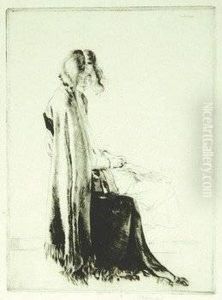Thomas Blakeley Mackenzie Paintings
Thomas Blakeley Mackenzie, born in 1887 in Liverpool, England, was a British painter known for his portraiture, landscape, and marine subjects. He developed his artistic talent from a young age and pursued formal training at the Liverpool School of Art, where he honed his skills in drawing and painting. His artistic education continued as he received scholarships that enabled him to study at the prestigious Royal College of Art in London.
Mackenzie's work began to gain recognition in the early 20th century. His style was influenced by the impressionist movement, though he retained a distinctive approach that combined impressionist elements with a more traditional British sensibility. He was particularly adept at capturing the interplay of light and color, which is evident in his landscapes and seascapes. These works often depicted the British countryside or the bustling ports of Liverpool, reflecting both the beauty of the natural world and the industrial vigor of the era.
As his career progressed, Thomas Blakeley Mackenzie exhibited his work at various institutions, including the Walker Art Gallery in Liverpool and the Royal Academy in London. His portraits, which included both private commissions and notable public figures, were praised for their technical skill and psychological depth. Mackenzie's ability to render his subjects with both realism and empathy won him a number of prestigious commissions and helped to establish his reputation as a leading portrait artist of his time.
Despite the outbreak of World War I, which disrupted the lives and careers of many artists, Mackenzie continued to paint and even served as an official war artist for a period. His wartime experiences influenced his work, introducing a somber tone to some of his later pieces. After the war, he returned to his pre-war subjects but with a greater sense of introspection and solemnity.
Thomas Blakeley Mackenzie's contributions to British art were cut short by his untimely death in 1944. However, his paintings continue to be appreciated for their technical mastery and evocative portrayal of early 20th-century Britain. His works are held in several public collections, and he is remembered as a significant figure in the art world of his time.



